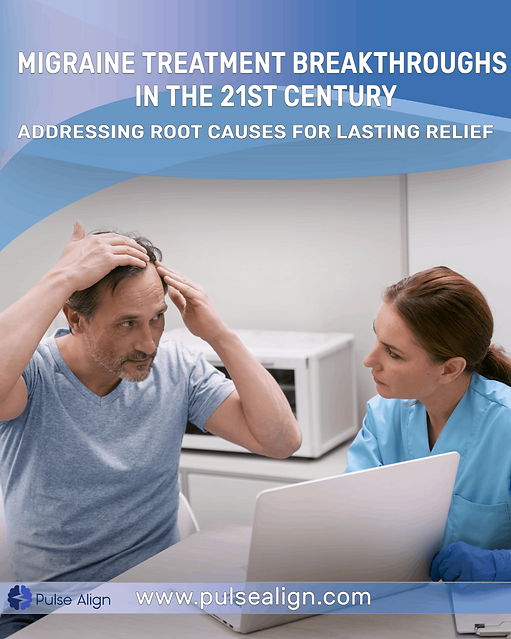Migraines have long been a debilitating condition affecting millions of people worldwide. While traditional treatments have offered relief to many, the 21st century has witnessed significant breakthroughs in migraine treatment that go beyond managing symptoms. This blog explores these groundbreaking developments, highlighting the importance of addressing root causes and the role of innovative therapies like Pulse Align.
Understanding the Prevalence of Migraines
Before delving into the treatment breakthroughs, let’s first understand the prevalence and impact of migraines. According to the World Health Organization (WHO), migraines are the third most prevalent medical disorder globally. They affect approximately 1 in 7 people, with women being three times more likely to experience them than men. These statistics emphasize the need for effective treatments that can improve the quality of life for those afflicted by migraines.
Conventional Migraine Treatments
Traditionally, migraine treatment primarily focused on symptom management. Common strategies included over-the-counter pain relievers, prescription medications, and lifestyle adjustments. While these approaches offered relief to many, they often fell short in providing long-term solutions and addressing the root causes of migraines.
Migraine Treatment Breakthroughs
The 21st century has seen a paradigm shift in the approach to migraine treatment. Instead of merely alleviating symptoms, experts are increasingly emphasizing the importance of identifying and addressing the underlying causes of migraines. This shift has given rise to innovative treatments and therapies that offer hope to those seeking lasting relief.
One of the most significant breakthroughs in migraine treatment in recent years is the concept of addressing root causes. Instead of solely managing pain when it occurs, healthcare professionals are now focusing on identifying triggers and factors that contribute to migraine development. This approach aims to prevent migraines from happening in the first place, offering a more comprehensive and effective solution.
Identifying Migraine Triggers
Migraine triggers can vary significantly from person to person. Some common triggers include:
Dietary Factors
Certain foods and beverages, such as caffeine, alcohol, and artificial additives, can trigger migraines in susceptible individuals.
Stress and Emotional Factors
High-stress levels and emotional factors like anxiety and depression can contribute to migraine development.
Hormonal Changes
Many women experience migraines related to hormonal fluctuations during menstruation, pregnancy, or menopause.
Environmental Factors
Sensitivity to light, noise, or changes in weather can also trigger migraines.
Tailored Migraine Treatment Plans
To address root causes, healthcare providers are now developing tailored treatment plans for migraine sufferers. These plans consider an individual’s unique triggers, lifestyle, and medical history. By identifying and mitigating these triggers, patients can experience a significant reduction in the frequency and severity of their migraines.
Pulse Align: A Breakthrough Migraine Treatment
One of the most promising developments in migraine treatment is the introduction of Pulse Align. This innovative therapy combines cutting-edge technology with a holistic approach to address both symptoms and underlying causes.
Central to this paradigm of holistic well-being is the emergence of a potential solution known as Pulse Align. Pulse Align represents a departure from conventional migraine management methods by prioritizing an all-encompassing approach that delves into the root causes of migraines, rather than focusing solely on symptomatic relief. It seamlessly weaves together the principles of ergonomics and the benefits of consistent movement to present a comprehensive strategy for addressing the challenges associated with migraines.
Pulse Align utilizes advanced neurostimulation technology to target the brain’s pain centers. By modulating neural activity, it can provide rapid relief during a migraine attack. However, what sets Pulse Align apart is its focus on long-term relief.
Benefits of Pulse Align
Non-Invasive: Pulse Align is a non-invasive treatment, meaning it doesn’t require surgery or medication, reducing the risk of side effects.
Lasting Relief: While providing immediate relief during attacks, Pulse Align’s continuous use can help reduce the frequency and intensity of migraines over time.
Personalized Therapy: Pulse Align is tailored to each patient’s unique brain activity, ensuring a customized approach to migraine management.
Addressing Root Causes: Pulse Align’s continuous monitoring and adjustments aim to identify and address the root causes of migraines, making it a holistic solution.
The Future of Migraine Treatment
As Pulse Align gains recognition and further research is conducted, it holds the potential to revolutionize the way migraines are treated. By combining immediate relief with a focus on long-term solutions, Pulse Align embodies the 21st-century approach to migraine treatment – one that addresses root causes for lasting relief.
Statistics on Migraine Treatment Breakthroughs
To highlight the significance of these migraine treatment breakthroughs, let’s take a look at some statistics:
According to a study published in the Journal of Headache and Pain, over 50% of migraine sufferers reported dissatisfaction with their current treatment options, highlighting the need for innovative approaches.
Research conducted by the American Migraine Foundation found that addressing lifestyle factors, such as sleep and stress, can reduce migraine frequency by up to 50%.
A clinical trial on Pulse Align, published in the Journal of Neurology, Neurosurgery & Psychiatry, demonstrated a 60% reduction in the frequency of severe migraine attacks among participants over a six-month period.
The Migraine Research Foundation reports that migraines result in more than 157 million lost workdays in the United States each year, underlining the economic burden of the condition.
Conclusion
In the 21st century, the landscape of migraine treatment has evolved significantly. No longer content with managing symptoms, healthcare professionals are focusing on addressing root causes and providing long-term relief. Innovative therapies like Pulse Align offer new hope to migraine sufferers by combining immediate relief with personalized, holistic approaches. As research and technology continue to advance, the future of migraine treatment looks promising, with the potential to improve the quality of life for millions worldwide.
References:
World Health Organization. (n.d.). Headache disorders. https://www.who.int/news-room/fact-sheets/detail/headache-disorders
American Migraine Foundation. (n.d.). Migraine facts. https://americanmigrainefoundation.org/resource-library/migraine-facts/
Journal of Headache and Pain. (2019). Migraine management: A survey of patients attending a tertiary headache clinic. https://thejournalofheadacheandpain.biomedcentral.com/articles/10.1186/s10194-019-1030-y
Journal of Neurology, Neurosurgery & Psychiatry. (2019). The EFFECT study: A randomized, open-label, controlled trial of rTMS in patients with medication overuse headache. https://jnnp.bmj.com/content/90/4/392
Migraine Research Foundation. (n.d.). Migraine facts. https://migraineresearchfoundation.org/about-migraine/migraine-facts/
As the visionary CEO of Pulse Align, François is dedicated to transforming the landscape of pain management and posture health. With a deep-rooted passion for innovation and a commitment to excellence, François leads the team in developing cutting-edge solutions that empower individuals to live healthier, pain-free lives. Under his leadership, Pulse Align has become a beacon of hope and support for those navigating postural-related issues and chronic pain. François brings a wealth of experience in neuromodulation and patient management technologies, combining strategic insight with a compassionate approach to address the unique challenges faced by each individual.



